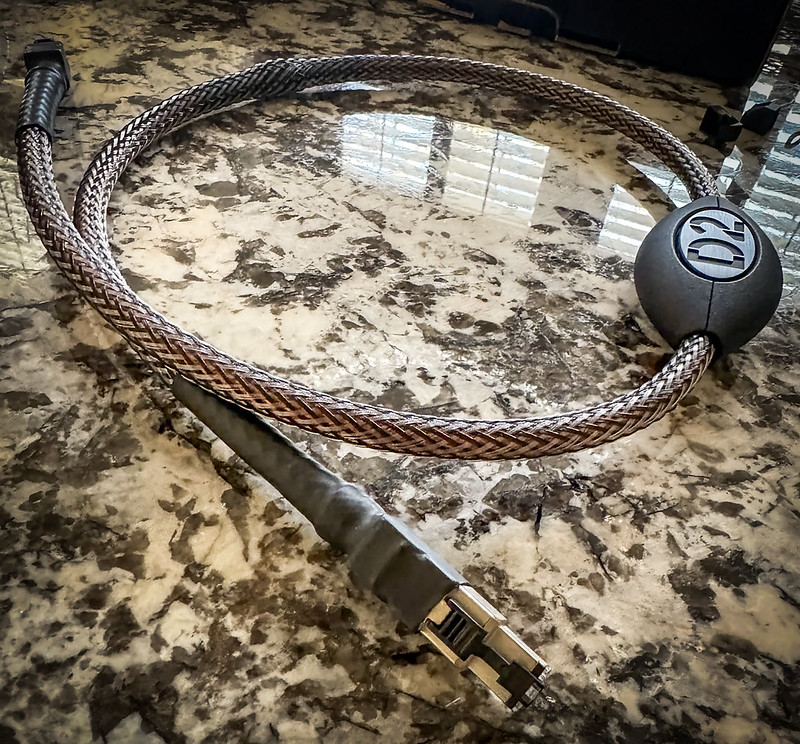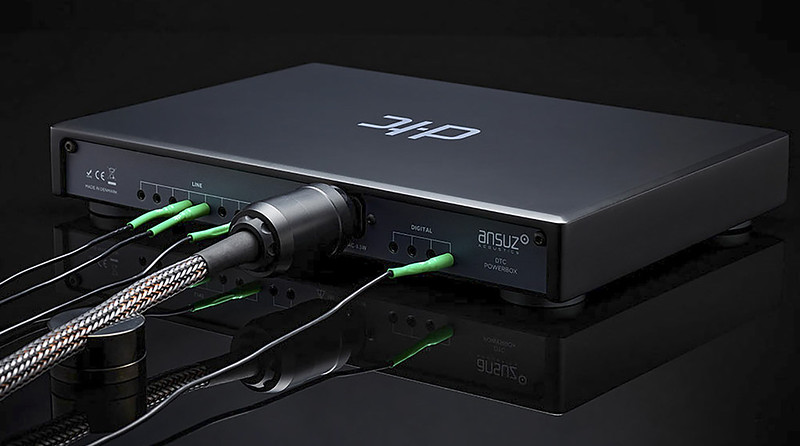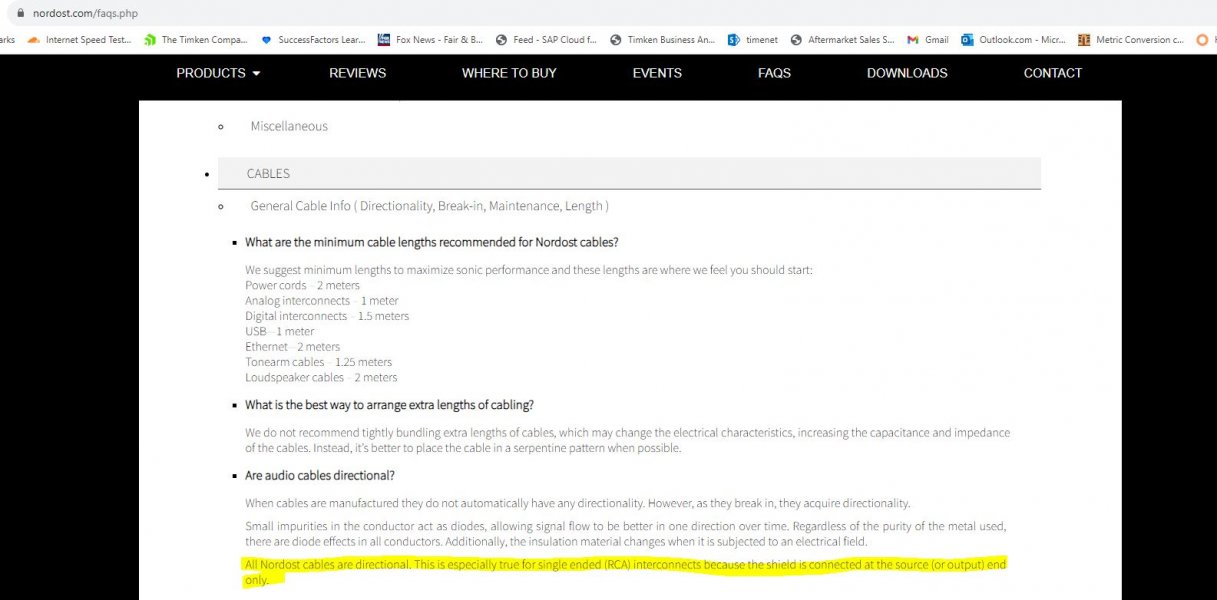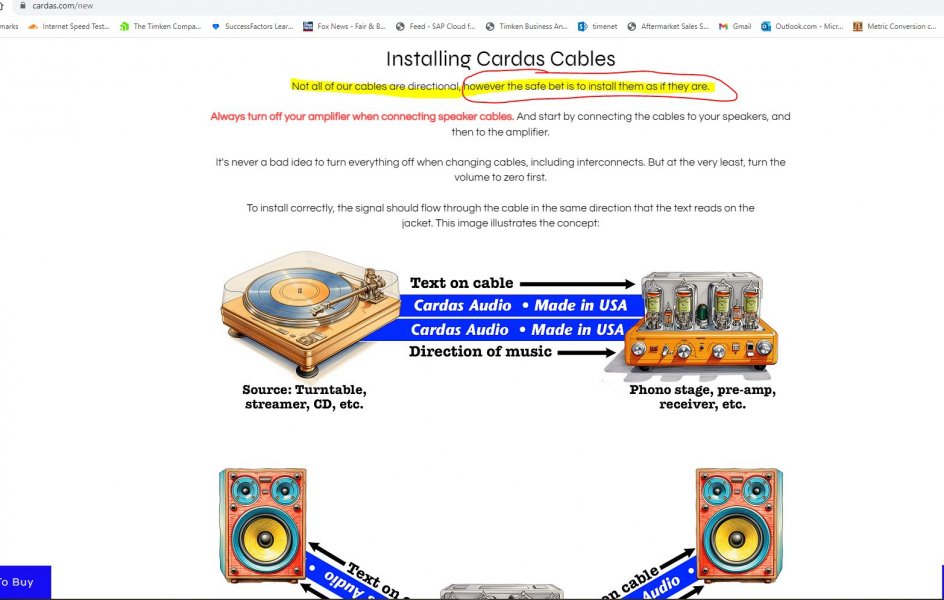As do Cardas, Nordost, DH Labs, Zavfino……“Directionality” refers to the concept that wire and cables sound better in one direction than the other. It’s because wire is electrically and physically asymmetrical. Due to the metal crystal structures being deformed during manufacture, when pulled through a die. Like quills on a porcupine as, it were. Some cable companies, relatively few, most notably AudioQuest, control “directionality” during manufacture. This “directionality” is separate from the shielding issue. For optimum results shielded cables should be controlled for both types of “directionality.”
Ethernet cables to and from your switch?
- Thread starter Antonio66
- Start date
You are using an out of date browser. It may not display this or other websites correctly.
You should upgrade or use an alternative browser.
You should upgrade or use an alternative browser.
It is on subject and cables do have directionality based on the extrusion process (occ copper and silver) as well as data cables, inclusive to shielding and extrusion.What do you mean by directional though? Yes, most (all?) wire will have been through a directional process eg extrusion but it has ever been thus. Do you mean this has an impact on sound quality? That a signal moves better/faster/quieter or something else in the direction of manufacture than in the opposite direction?
I guess there are at least a couple of questions buried in that:
- how do we know which is the "right" direction?
- what do we do about it if we do know? I think most of us here would draw the line at unwinding and reversing transformer wire... or reversing internal wires in a component...
I suggest generally not worrying about this unless we know for certain there is a mechanism by which installing wires in the "right" direction improves sound quality.
There are notable exceptions though. Some manufacturers designate cable directionality not just as an adornment but because there is something structurally different in the cable. For example, Townshend speaker cables use a (Zobel?) filter at one end, and - back on topic - the Melco C100 has its shield grounded at only one end. These are structurally directional, we're not talking molecular alignment or whatever.
Pretty sure Nordost is speaking about their shielded cables. I saw a comment on quick internet search that Cardas cables are not (rpt not) all directional. Who wouldn’t make all their cables directional If they were a proponent of directionality? I suspect they’re referring to their shielded cables, too. IIRC the companies Anti Cables and Goertz control directionality In the sense I’m referring to.
Last edited:
Not what their FAQ says: https://www.nordost.com/faqs.phpPretty sure Nordost is speaking about their shielded cables. I saw a comment on quick internet search that Cardas cables are not (rpt not) all directional. Who wouldn’t make all their cables directional If they were a proponent of directionality? I suspect they’re referring to their shielded cables, too. IIRC the companies Anti Cables and Goertz control directionality In the sense I’m referring to.
Attachments
Always follow OE Instructions.....Pretty sure Nordost is speaking about their shielded cables. I saw a comment on quick internet search that Cardas cables are not (rpt not) all directional. Who wouldn’t make all their cables directional If they were a proponent of directionality? I suspect they’re referring to their shielded cables, too. IIRC the companies Anti Cables and Goertz control directionality In the sense I’m referring to.
Attachments
According to the first link Nordost is not (rpt not) on board the directionality train. They did some pretty fancy hand waving I’ll give them that. And your last link doesn’t make much sense either, it just shows Nordost isn’t on board the directionality train.
Last edited:
How much clearer is ALL NORDOST CABLES ARE DIRECTIONAL. Hitting the ignore button with you.According to the first link Nordost is not (rpt not) on board the directionality train. They did some pretty fancy hand waving I’ll give them that. And your last link doesn’t make much sense either, it just shows Nordost isn’t on board the directionality train.
DH Labs are in the same boat as Nordost and Cardas, their use of the term directional refers only to shielded cables.
from DH Labs web page,
from DH Labs web page,
Are DH Labs Silver Sonic cables "directional"?
Cables are directional for shielding purposes only and most have arrows. Should you not see these arrows, remember that the signal flow should go in the same direction of the print on the cable jacket, reading left to right away from the source (source to destination)
Last edited:
Getting in an Ansuz D2 ethernet cable (connected to my DTC PowerBox).
Guess it would go between the Switch and the Muon Pro filter.
Then I have my current Final Touch Metis cable from the Muon filter to the Aurender music server/Streamer.


Guess it would go between the Switch and the Muon Pro filter.
Then I have my current Final Touch Metis cable from the Muon filter to the Aurender music server/Streamer.


Last edited:
This is what Nordost says on their web site. Thproves they are not on the directionality choo choo train. Cables don’t acquire directionality, they are inherently directional before you even hook them up. All the quantum tunneling and diode effect gobbledygook notwithstanding.
“
“When cables are manufactured they do not have any directionality. However, as they break in, they acquire directionality. Although the cable signal is an alternating current, small impurities in the conductor act as diodes allowing signal flow to be better in one direction over time. This effect is also called quantum tunneling, which has been observed in experiments over 25 years ago. Regardless of the purity of the metal used, there are still diode effects in all conductors. In addition, the insulation material will change when it is subjected to an electrical field.”
The following AudioQuest explanation is much closer to what I mean when I use the terms wire or cable directionality.
 www.audioquest.com
www.audioquest.com
“
“When cables are manufactured they do not have any directionality. However, as they break in, they acquire directionality. Although the cable signal is an alternating current, small impurities in the conductor act as diodes allowing signal flow to be better in one direction over time. This effect is also called quantum tunneling, which has been observed in experiments over 25 years ago. Regardless of the purity of the metal used, there are still diode effects in all conductors. In addition, the insulation material will change when it is subjected to an electrical field.”
The following AudioQuest explanation is much closer to what I mean when I use the terms wire or cable directionality.
News Article
AudioQuest cables and other audio products combine solid conductors, high-purity metals, specialized geometries, and stable dielectrics to enable naturally beautiful sounds and images.Thanks. You haven't said what directionality means though. Do you mean most cables generally sound better one way than the other, even if there is no structural difference eg shield grounding or filters? If so, is it down to the listener/owner to determine which they prefer or does each cable have a generally preferred/better direction?It is on subject and cables do have directionality based on the extrusion process (occ copper and silver) as well as data cables, inclusive to shielding and extrusion.
I'm not a cable sceptic by the way, but I'm currently a bit of a cable directionality sceptic and seeking enlightenment.
Well it could go there but you could also try it between the Muon Pro and the Aurender. I certainly would! Basically, you want to ensure the most effective device/cable is latest in the chain in my experience, so worth experimenting.Getting in an Ansuz D2 ethernet to try in my system.
Guess it would go between the Switch and the Muon Pro filter.
Then I have my current Final Touch Metis cable from the Muon filter to the Aurender music server/Streamer.
Report back!
We need to separate out structural directionality like filters and sheld grounding from molecular directionality (or whatever you want to call it) which has no structural difference between the ends of the cable. Making broad statements or raising broad questions about directionality without this differentiation doesn't really help as it all comes down to some sort of vague Directionality Believer/Non-believer thing which usually ends in tears.Pretty sure Nordost is speaking about their shielded cables. I saw a comment on quick internet search that Cardas cables are not (rpt not) all directional. Who wouldn’t make all their cables directional If they were a proponent of directionality? I suspect they’re referring to their shielded cables, too. IIRC the companies Anti Cables and Goertz control directionality In the sense I’m referring to.
Just added the Ansuz D2 Ethernet cable to my system a few days ago. Huge improvement over the Audioquest Diamond I was using. I have a Ansuz D2 Powerswitch arriving in two days. It will be interesting to see how much the active shielding adds.Getting in an Ansuz D2 ethernet to try in my system.
Guess it would go between the Switch and the Muon Pro filter.
Then I have my current Final Touch Metis cable from the Muon filter to the Aurender music server/Streamer.

@TheFlash, fair enough, allow me to post again this news article by AudioQuest, a notable “directionality” proponent. With this “directionality“ in mind, one should perhaps deduce that all (rpt all) wire and all cables are “directional,“ because they are physically and electrically asymmetrical. Electrons would much prefer to move in the same direction as the crystal structure deformation than against it. The deformation of the crystal structures goes down well below the surface of the wire.
Last edited:
Seek enlightenment from the manufactures, most will have a FAQ on their website and explanations and what are the indicators for direction if their are not arrows to indicate. As I said in an earlier post, I follow the OE instructions for proper installation. You are free to be a sceptic I am not here dissuade you.Thanks. You haven't said what directionality means though. Do you mean most cables generally sound better one way than the other, even if there is no structural difference eg shield grounding or filters? If so, is it down to the listener/owner to determine which they prefer or does each cable have a generally preferred/better direction?
I'm not a cable sceptic by the way, but I'm currently a bit of a cable directionality sceptic and seeking enlightenment.
Thanks. One could indeed deduce that, but I'm not sure I understand why one would. Crystal structures? Preference? Deformation? What would the electrons not preferring the direction in which they are being directed result in? Lower current? Lower voltage? More noise?@TheFlash, fair enough, allow me to post again this news article by AudioQuest, a notable “directionality” proponent. With this “directionality“ in mind, one should perhaps deduce that all (rpt all) wire and all cables are “directional,“ because they are physically and electrically asymmetrical. Electrons would much prefer to move in the same direction as the crystal structure deformation than against it. The deformation of the crystal structures goes down well below the surface of the wire.
When you merge "physically and electrically" like this, you miss structurally which is different and nothing to do with how the wires were drawn or have been burned in or whatever.
I can't find anything published by a scientfic journal or similar which talks about directionality in wires. If this is a thing, surely it affects more than music? No offence to Audioquest or Nordost but I'm struggling to get my head around what is suggested might be happening electrically, whether measurable (I'm not of that camp) or not.
And I'm not here to be persuaded or dissuaded, I'm merely trying to understand what might be happening. I've read all the FAQs I can find and they don't generally help. As I've said, directionality where it is structural and designed/manufactured in from the outset, I get. But at the molecular/crystal level, I'm in sceptic territory as I think this would affect satellites and nuclear reactors and weapon systems and stuff so would be the subject of actual scientific papers explaining why directionality should be of general concern and what to do about it. I can't find any of these.Seek enlightenment from the manufactures, most will have a FAQ on their website and explanations and what are the indicators for direction if their are not arrows to indicate. As I said in an earlier post, I follow the OE instructions for proper installation. You are free to be a sceptic I am not here dissuade you.
Well then it time to move along... if the cable has a directional arrow then use it. If not then it is all up to you. Maybe this will help, I am out now. https://www.audioquest.com/theory-education/article/83-directionality-its-all-about-noise#:~:text=There is the widely accepted,thus defining the cable's directionality.And I'm not here to be persuaded or dissuaded, I'm merely trying to understand what might be happening. I've read all the FAQs I can find and they don't generally help. As I've said, directionality where it is structural and designed/manufactured in from the outset, I get. But at the molecular/crystal level, I'm in sceptic territory as I think this would affect satellites and nuclear reactors and weapon systems and stuff so would be the subject of actual scientific papers explaining why directionality should be of general concern and what to do about it. I can't find any of these.
But the definitive empirical evidence of directionality demands seeking a scientific explanation. What is the technical explanation for directionality?
In order to fabricate copper or silver into a strand or conductor, it must first be cast and then drawn through a die—a process that inevitably creates a directional, chevron-like pattern in the conductor’s internal grain structure and a non-symmetrical overlay of grains at the conductor’s surface.
While most are either unaware of conductor directionality or have chosen to ignore it, we have learned to use conductor directionality to our advantage.
A conductor’s asymmetrical surface structure causes a directional difference in impedance at noise frequencies and very high interference frequencies. Due to skin-effect, such high-frequency energy travels almost exclusively on the surface of a conductor, giving significance to the directional difference in impedance at these frequencies. Because all energy will always take the path of least resistance, when a cable is oriented so that the high-frequency noise—whether from a computer, radio station, cell tower, etc.—is “directed” to ground, or to the end of the cable attached to less vulnerable equipment, the dynamic intermodulation and associated ringing generated in the active electronics will be greatly reduced.
Our efforts toward the proper dissipation of noise are not limited to our analog and digital cables, but extend to other AudioQuest products, as well—most recently evidenced in our Niagara 1000 and 7000 Low-Z Power Noise-Dissipation Systems, in which every single link in the conducting path has been properly controlled for low-noise directionality.
As always, the proof is in the listening.
The unpleasant, strained sound that occurs when conductors have the wrong orientation is the result of noise entering and causing misbehavior and intermodulation in an active circuit. The more relaxed, full-bodied sound of correctly oriented conductors is the product of less high-frequency interference—conductor directionality fully acknowledged and put to its best use!
TheFlash wrote,
”I can't find anything published by a scientfic journal or similar which talks about directionality in wires. If this is a thing, surely it affects more than music? No offence to Audioquest or Nordost but I'm struggling to get my head around what is suggested might be happening electrically, whether measurable (I'm not of that camp) or not.”
I never said it was in a scientific journal or similar. I assume you looked through all scientific journals to get your answer.
I’m going to help you out. Here is shat I wrote over in a thread regarding fuses several days ago,
“If memory serves HiFi Tuning used to have a symbol on the fuse, a diode I think, which was to alert the user the fuse was directional. As I recall the diode symbol with an arrow wasn’t necessarily pointing the direction the fuse should go in the circuit but rather just a way to keep track of which way to flip the fuse when listening for correct directionality.
Not to mention the *fuse data sheets* that were published on HiFi Tuning’s web site - are they still there? - that provided evidence of electrical directionality, I.e., the voltage drop lower is in “correct direction,” not only for their fuses but all fuses that were tested, including stock run of the mill fuses. The data sheets also showed the positive electrical effect of cryogenically treating fuses, as I recall the tests were performed by an independent testing company.””
”I can't find anything published by a scientfic journal or similar which talks about directionality in wires. If this is a thing, surely it affects more than music? No offence to Audioquest or Nordost but I'm struggling to get my head around what is suggested might be happening electrically, whether measurable (I'm not of that camp) or not.”
I never said it was in a scientific journal or similar. I assume you looked through all scientific journals to get your answer.
I’m going to help you out. Here is shat I wrote over in a thread regarding fuses several days ago,
“If memory serves HiFi Tuning used to have a symbol on the fuse, a diode I think, which was to alert the user the fuse was directional. As I recall the diode symbol with an arrow wasn’t necessarily pointing the direction the fuse should go in the circuit but rather just a way to keep track of which way to flip the fuse when listening for correct directionality.
Not to mention the *fuse data sheets* that were published on HiFi Tuning’s web site - are they still there? - that provided evidence of electrical directionality, I.e., the voltage drop lower is in “correct direction,” not only for their fuses but all fuses that were tested, including stock run of the mill fuses. The data sheets also showed the positive electrical effect of cryogenically treating fuses, as I recall the tests were performed by an independent testing company.””
Similar threads
- Replies
- 37
- Views
- 3K
- Replies
- 9
- Views
- 4K
Members online
- DW101
- nafis
- Abolive
- analogsa
- Odd Harry
- Inline Six
- agencal
- Ken_loves_classical
- fxg
- Lynnot
- Argonaut
- Johan K
- dennis h
- micha b.
- Achilles
- Adcc
- mtemur
- morricab
- emergency
- thekong
- the sound of Tao
- admin1959
- luca.pelliccioli
- hogen
- kimurastanley
- kostas6a3
- Mark212121
- Dunc69
- Audio Quack
- digit_linn
- bally_le1
- fbs
- Azjya
- Crom
- Emilzebira
- SOS
- Emorante
- Rob77
- Beltane_sun
- Tbzc
- bonzo75
- UEM
Total: 1,261 (members: 45, guests: 1,216)
| Steve Williams Site Founder | Site Owner | Administrator | Ron Resnick Site Co-Owner | Administrator | Julian (The Fixer) Website Build | Marketing Managersing |











